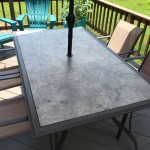Stamped Concrete Patio Ideas: Enhancing Outdoor Living Spaces
Stamped concrete patios have emerged as a popular and versatile option for homeowners seeking to enhance their outdoor living spaces. This technique involves imprinting textures and patterns onto freshly poured concrete, mimicking the appearance of more expensive materials like natural stone, brick, or wood. The result is a durable, aesthetically pleasing, and cost-effective patio surface that can significantly elevate the overall appeal of a property.
The appeal of stamped concrete extends beyond its aesthetic qualities. It offers a practical solution for creating durable and low-maintenance patios that can withstand the rigors of outdoor use. Unlike individual pavers or stones, stamped concrete eliminates the potential for shifting or settling, leading to a smoother and more even surface over time. This makes it an ideal choice for areas that experience heavy foot traffic or are exposed to harsh weather conditions.
Furthermore, stamped concrete offers a wide range of design possibilities, allowing homeowners to customize their patios to match their personal preferences and complement their existing landscape. The flexibility in terms of colors, patterns, and textures allows for the creation of unique and visually stunning outdoor spaces. This article will explore various stamped concrete patio ideas, focusing on key considerations for design, pattern selection, color choices, and maintenance.
The Advantages of Stamped Concrete Patios
Stamped concrete patios offer several key advantages over traditional patio materials. One of the primary benefits is cost-effectiveness. While the initial investment may be slightly higher than plain concrete, it is often significantly less expensive than installing natural stone or brick patios. The labor costs associated with stamped concrete are also generally lower, as the installation process is relatively streamlined.
Durability is another significant advantage. Stamped concrete is highly resistant to cracking, chipping, and fading, making it a long-lasting and reliable option for outdoor use. When properly sealed, it can withstand exposure to extreme temperatures, moisture, and UV rays. This longevity translates to lower maintenance costs over the lifespan of the patio.
Maintenance requirements are minimal for stamped concrete patios. Regular cleaning with a mild detergent and water is typically sufficient to keep the surface looking its best. Periodic resealing, typically every two to three years, is recommended to protect the color and texture from fading and to prevent water penetration. This simple maintenance routine ensures that the patio retains its beauty and functionality for many years.
Design Considerations for Stamped Concrete Patios
Planning is crucial when designing a stamped concrete patio. The size and shape of the patio should be carefully considered to ensure that it fits seamlessly into the landscape and provides adequate space for intended use. Consider the placement of outdoor furniture, grilling areas, and other features when determining the patio's dimensions.
The style of the home and surrounding landscape should also influence the design choices. A modern home may benefit from clean lines and minimalistic patterns, while a more traditional home may be better suited to rustic textures and natural-looking colors. Consider the architectural details of the house, such as the roofing material and siding, when selecting the pattern and color of the stamped concrete.
Accessibility is another important factor to consider. Ensure that the patio is easily accessible from the house and other areas of the yard. Consider incorporating ramps or gently sloping pathways to accommodate individuals with mobility issues. Proper drainage is also essential to prevent water from pooling on the patio surface. The patio should be slightly sloped away from the house to allow rainwater to run off effectively.
Pattern Selection: Replicating Natural Materials
The pattern of the stamped concrete is a critical element in achieving the desired aesthetic. One of the most popular options is to replicate the look of natural stone. Patterns such as flagstone, slate, and cobblestone can create a rustic and timeless appeal. These patterns are particularly well-suited for patios that are intended to blend seamlessly with natural surroundings.
Brick patterns are another common choice, offering a classic and elegant look. Herringbone, running bond, and basketweave patterns can create a visually appealing effect, particularly when combined with complementary colors. Brick patterns are often used in more formal or traditional settings.
Wood plank patterns are a relatively newer trend, providing the warmth and beauty of wood without the maintenance concerns. These patterns can mimic the appearance of various wood species, such as cedar, oak, or redwood. Wood plank patterns are a great option for creating a cozy and inviting outdoor space.
Beyond replicating natural materials, there are also a variety of more abstract and contemporary patterns available. Geometric patterns, such as squares, rectangles, and circles, can create a visually striking effect. These patterns can be particularly effective in modern or minimalist settings. Borders and accents can also be added to enhance the overall design. Different patterns can be combined to create unique and personalized designs.
Color Choices: Enhancing the Patio's Aesthetics
The color of the stamped concrete plays a significant role in the overall aesthetics of the patio. The color should complement the surrounding landscape and architectural features of the home. Neutral colors, such as grays, tans, and browns, are a popular choice for creating a natural and understated look. These colors blend well with a variety of landscaping styles and architectural designs.
For those seeking a bolder look, darker colors, such as charcoal gray or deep brown, can create a dramatic and sophisticated effect. These colors can be particularly effective in modern or contemporary settings. However, it is important to note that darker colors can absorb more heat, which may make the patio surface hotter to the touch in direct sunlight.
Adding color to stamped concrete can be achieved through various methods. Integral color is added to the concrete mix before it is poured, providing a uniform color throughout the entire slab. This method is ideal for achieving consistent color and is less susceptible to fading over time. Color hardeners are applied to the surface of the concrete after it is poured, creating a denser and more durable surface with enhanced color. This method allows for a wider range of color options and can create a more vibrant and textured look.
Release agents are used to prevent the stamping tools from sticking to the concrete. These agents can also add color to the surface, creating a subtle antiquing effect. This technique can enhance the texture and depth of the stamped pattern, giving it a more natural and aged appearance. Stains and sealers can also be used to add color and protect the stamped concrete from the elements. These products can be applied after the concrete has cured and can be used to refresh the color or add a protective layer.
Maintenance and Care for Stamped Concrete Patios
Proper maintenance is essential to preserve the beauty and longevity of a stamped concrete patio. Regular cleaning is the first step in maintaining the patio. Sweep the surface regularly to remove dirt, leaves, and other debris. Wash the patio with a mild detergent and water to remove stains and grime. A pressure washer can be used for more stubborn stains, but it is important to use a low-pressure setting to avoid damaging the surface.
Sealing the stamped concrete is crucial to protect it from the elements. Sealers create a barrier that prevents water, oil, and other substances from penetrating the surface. This helps to prevent staining, fading, and cracking. It is recommended to reseal the patio every two to three years, or more frequently in areas with heavy traffic or harsh weather conditions. Choose a high-quality sealer that is specifically designed for stamped concrete.
Avoid using harsh chemicals or abrasive cleaners on the stamped concrete patio. These products can damage the surface and cause discoloration. Use only mild detergents and avoid using bleach or ammonia-based cleaners. Promptly remove spills of oil, grease, or other staining substances. Clean up spills as soon as possible to prevent them from penetrating the surface and causing permanent stains.
Protect the patio from heavy objects or sharp edges. Avoid dragging heavy furniture or equipment across the surface, as this can scratch or chip the concrete. Use furniture pads under the legs of chairs and tables to prevent damage. In areas that experience freezing temperatures, avoid using de-icing salts on the patio. These salts can damage the concrete and cause it to deteriorate. Consider using a sand-based de-icer instead.
By following these maintenance tips, homeowners can ensure that their stamped concrete patio remains a beautiful and durable outdoor living space for many years to come. The combination of careful design, appropriate pattern and color selection, and diligent maintenance will contribute to the long-term value and enjoyment of the patio.

5 Patio Ideas For Your Backyard Sam The Concrete Man Mobile

42 Inspiring Stamped Concrete Patio Ideas Designs Backyard

Backyard Stained And Stamped Concrete Patios

Stamped Concrete Patio Ideas The Cards We Drew

Custom Decorative Concrete Patio Designs For Your Renovation

42 Inspiring Stamped Concrete Patio Ideas Flooring Pavers Design Tiles

Stamped Concrete Design Ideas Pros Cons Types Network

Stamped Concrete Walkway And Patio Area Best Designs Inner City Skyline General Contractors In Southern

Cincinnati Stamped Concrete Patios All Decked Out

Stamped Concrete Decorative Colored Patio








